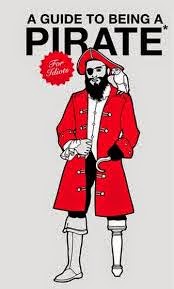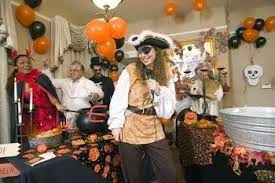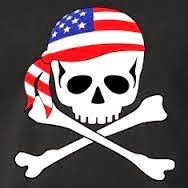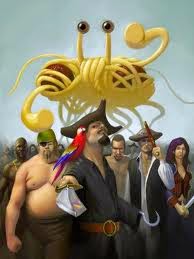“But what happened to him?” is a question that comes up at the end of many pirate stories. The end is always "he died," for the simple reason that the pirates lived 300 years ago, and no one survives that long. A better question might be “What was his fate?” Pirates seem to have been moved by fate. They came to a variety of endings.
One of the first “classical” pirates, in the terms of sailing the Caribbean and taking gold from the Spanish, was Sir Francis Drake. While he is considered a naval hero by the British, he was a pirate to the Spanish he robbed, and since he stole the goods when England and Spain were not at war, he counts as a pirate here.
Drake continued his explorations until he was over fifty, an incredible age for a sailor in his day. He died of intestinal sickness on the Spanish Main, and asked to be buried at sea in full dress armor, a wish that was carried out. His expedition not only followed his wishes, they even put together a solid lead coffin for him. Divers and explorers are still searching for this coffin, which would be one of the greatest pirate “finds” of all time.
Henry Morgan, the last of the great buccaneering pirates, died on August 25th 1688. As a reward for his success in fighting the Spanish, Morgan had been knighted and made the Lieutenant Governor of Jamaica, a largely honorary position, even though there was no official governor at the time.
Morgan used his position to spend all his time in taverns, reliving his exploits with worshipful sailors. His death came from liver failure. He was buried in Port Royal with full military honors. Every ship in the harbor fired a salute, and the entire town took a day of mourning. Morgan’s grave was sunk beneath the sea during the Port Royal earthquake of 1692.
No one knows the fate of Henry Avery, the pirate whose carrier may be said to mark the beginning of the Golden Age of Piracy. Avery was last seen in March of 1696, in the port of New Providence in the Bahamas, where he was off-loading the incredible riches he had captured from a treasure ship of the Grand Moghul of India.
Moralists of his day claimed that he was later tricked out of his entire fortune by a dishonest merchant, and died a beggar in Bristol, England. He was also rumored to have simply changed his name and retired to a life of comfort. I have seen no evidence that proves either belief, so you may believe as you choose.
Benjamin Hornigold, the pirate teacher who influenced the careers of over a thousand pirates during the Golden Age, received a pardon for his crimes in January of 1718. This general amnesty for all pirates who agreed to stop robbing ships was a tacit agreement by the British government that they could not defeat the pirates. It was the end to many a pirating career.
Hornigold, lacking any job sills apart from captaining ships, later became a pirate hunter. He was killed when his ship ran aground in 1719.
Henry Jennings, Hornigold’s political and personal rival, also took the pardon, but he had amasses a considerable fortune as a pirate. He used this fortune to purchase a plantation in Bermuda. Jennings is widely regarded as the only pirate to enjoy a really successful retirement, and lived the life of a country gentleman until the end of his days.
Sam Bellamy, star pupil of Hornigold and one of the richest pirates at the time of his death, went down with his ship, the Whydah Galley, on April 26th, 1717 off the coast of Massachusetts in a massive storm. Of the eight pirates who escaped, six were hanged, and two (a Black man raised in the Netherlands and a half-African, half Native American) were sold into slavery.
Bellamy had supposedly been going to visit his fiancé, Mary (or Maria) Hallett. Mary was rumored to be a witch, and some said that they saw her on the headlands the night of the storm, encouraging the sea in its violence. They said she was angry at Sam for deserting her. But other claim that she was trying ot save her lover, and that the two were reunited and ran away together.
Hornigold’s other famous pupil, Blackbeard, retired successfully. He took the pardon in June of 1718, and settled in the town of Bath, North Carolina. He married a local plantation owner’s daughter, and might have lived quietly. But it seems that he became bored, and began robbing ships again.
The Royal Navy wasn’t doing enough to catch the pirates, so the Governor of Virginia offered an off-the-books reward, which lured Lieutenant Robert Maynard to bring two navy sloops and attack Blackbeard near his hideout on Oracoke Island. After a ferocious battle in which Blackbeard was wounded 26 times, Maynard at last prevailed. He hacked off Blackbeard’s head and displayed it on the bowsprit of his ship. The body was thrown overboard, where according to witnesses it swam 3 times around the ship before disappearing beneath the waves.
Some people say that the end of the Golden Age of Piracy ended in 1720, with the hanging of Calico Jack Rackham. Jack had been run down by the British navy when he and his crew were dead drunk after a night of celebration. Jack and his crew were too intoxicated to fight back, though Anne Bonny and Mary Read almost held off the entire attacking force by themselves.
Jack was tried in Jamaica and sentenced to be hanged. On November 18th, he was granted his final wish and taken to see his true love, Anne, at the door of her jail cell. She was not sympathetic, and told him that if he had fought like a man, he would not now be hanged like a dog.
Anne herself, sentenced to be hung after the birth of Jack’s child, disappeared from the jail and from history. Legend has it that she escaped, married, bore 16 children and lived to be 82 years old.
Wrecked, defeated, captured (while drunk) killed by sickness or by their own weakness, pirate made their mark upon the world. Though they may have left this earth years ago, they have, in some way, become immortal.
Fascinating facts about Pirates, their lives, weapons, ships, and history, by the author of The Pirate Empire, available on Amazon.
Monday, August 25, 2014
Monday, August 18, 2014
How to be a Pirate
Have you ever daydreamed of actually being a
pirate? Do all the stories about the Golden Age, when ships were wooden, men
were iron, and everyone partied nonstop, make you long to ditch your office or
your classes and run off to the Caribbean to do something illegal?
I can’t condone actually robbing people. You’ve
got to remember that robbing folks is what got pirate hung in the city square.
But life is about having fun, and there are some things that you can do to add
a little pirate panache to your everyday life.
By all means, party. Pirates knew their lives
might end any day, so they lived every day to its fullest. In today’s life,
that means not sitting around the house, not getting sucked into TV or the
internet. Go out… explore. Real pirates sailed from the Caribbean to Africa to
Asia, just on a whim. If you can’t afford this kind of world travel, make a
simple effort to get out to a nearby festival, drive to a city you’ve never
visited, meet new people. (But don’t rob them.) Be a participant, not just a
viewer.
And please remember, real pirates were patrons of
the arts. They performed in shipboard plays, and employed musicians. So go out
and see something live! It’s part of being alive all the time, and it will
enrich your life.
Real pirates were never jaded or disaffected. They
had no time to be bored.
Swashbucklers during the Golden Age of Piracy did
not judge others based on nationality or skin color. Pirate crews were white,
black, Indian (both East and West), Chinese and even Japanese. So if you want
to be more piratical, make an effort to meet and get to know a wide range of
people. And don’t judge. Pirate culture was the one place, back in the day,
where race, religion and even education didn’t matter.
And speaking of education, it wouldn’t hurt at all
to become a lifetime learner, someone with an open mind, even a philosophical
bent. We have evidence that pirate ships were places where knowledge was
shared, such as it was. It was a place where working class people had enough
leisure to pick up skills like reading for the first time. On a higher level,
the art of navigation was also taught and studied. It was important to know
where the ship was. Navigation involved a lot of advanced mathematics, but
these guys just tucked in and learned it.
So if you want to be more like a pirate, keep your
mind open and learn what you can.
If you have a desire to fight in battles, I
suggest joining the civil rights movement. Pirates left the safety of life as a
common sailor because they wanted to be recognized as human, with dignity and
rights, in a world that didn’t offer those things to people with little
property and no fixed address. Admittedly, the world is a lot better now, but
there are still many battles to be fought. Just check out the news if you doubt
me.
But, you say, this isn’t as exciting as firing a
cannon or waving a saber. Don’t count on that. If you belong to a group that
meets in person and does work for social justice (Occupy is still a presence in
many places, and there’s also Amnesty International, the NAACP, SouthernPoverty Law Center, The Innocence Project and many, many more.) you will form
the same kinds of battle-forged friendships that people who have actually
fought together. Fighting these fights
is challenging, legal, and will help to make the world a better place.
Remember, pirates were out after justice, and went
as far as putting ship’s captains on trial to decide if they deserved to be
punished for treating their crews unfairly. So, in a manner of speaking,
fighting for justice is one of the most piratical things you can do.
An additional thing that you can do that real
pirates really would have approved of, something they fought and died to
achieve, was to VOTE. Pirates, and later working-class people of all kinds,
fought and died to earn the right to vote on things that affected their lives. These
folks would never understand why someone who has been given the ability to vote
wouldn’t use it. The fact that pirates risked their lives just to have a voice
was probably one of the most amazing things that I discovered, but it’s true.
Read more of this blog, or do some research on your own, and you’ll see that it’s
true.
I dress up like a pirate, and I certainly drink
rum. But I also fight the good fight, take a few risks, and do my best to help
out those less fortunate than myself.
How about you? Ready to be a pirate?
Monday, August 11, 2014
Two Kinds of Pirate
Pirating is one of the oldest professions, and it has been practiced all over the world. But when we think of pirates, it’s almost always the Caribbean we imagine, with its blue waters, its rum, and its bands of jolly cut-throats, who might do anything except what authority tells them to.
And yet there are two different kinds of pirates in the Caribbean, and today we’ll talk about what sets them apart from each other.
The first group falls into a period of roughly a hundred and thirty years, from about 1560 to 1688, bounded on one side by Sir Francis Drake, and on the other by Sir Henry Morgan. They included the likes of Sir John Hawkins, Sir Thomas Cavendish and Sir Humphrey Gilbert.
You may have noticed that all these men were knighted (which seems an odd fate for a pirate), evidenced by the “sir” before their names. The reason for this was that they were, at least nominally, all working for the English government, and they were most certainly sending a considerable part of their profits home to enrich that government. This sort of behavior was enough to get nearly anyone knighted, no matter what he’s been up to.
For in spite of their loyalty to their reigning monarch, they got into a lot of trouble. Drake was financed by Queen Elizabeth I to sail around the world. He was the leader of the second expedition to do it. (Magellan gets the credit for doing it first, but he didn’t live to complete the journey.) Drake made his money by sacking several Spanish galleons, and payed off his investors at a rate of 4,700%. Queen Elizabeth took her share and paid off the national debt with it.
Raleigh was also considered a pirate by the Spanish, a hero to his home country of England. He was so good at removing gold from Spanish hands that Elizabeth encouraged him to found the first colony in North America. Roanoke colony didn’t survive, and Raleigh got into considerable trouble through a secret marriage to a noblewoman. He ended up with his head cut off.
Hawkins (possibly the inspiration for the name Jim Hawkins in the novel Treasure Island) caused enough disruption that he inspired the Spanish to prohibit all English commerce in the Caribbean (a prohibition that was entirely ignored by other English adventurers.)
Morgen sailed under Letters of Marque, documents that licensed him to take specific actions against the Spanish. But he never really paid any attention to the requirements of these letters. He needed success, both for his backers and for the pirates who sailed under him, and if his assigned mission did not prove profitable he simply attacked somewhere else.
This got him into such trouble that he was recalled to England to stand trial for his disobedience. The intent was to hang him, but his many friends (men whom he had enriched) came to his aid, and he was knighted and send back to Jamaica as Lieutenant Governor, where he lived out his life hanging out in dockside taverns and drinking himself to death.
These men came from middle-class families, and had some education. They were funded by their government and by rich merchants in an era where anything was possible. Their logic seemed to be that if they were far enough away from home, they could get away with anything, and they were mostly right.
In these early years, sailing in general was a communal profession. All the ship’s crew risked their lives (some voyages of exploration had 90% casualty rates) and all shared in the profits.
Often these men attacked the Spanish on land. They proved daring tacticians and inspiring leaders, as they sacked settlements and captured forts. On land they had leisure to spend days or weeks raping, burning and pillaging. To the Protestant English, the Catholic Spanish were barely human, and they had no compunction in treating them without humanity. When the Spanish, sure of their God-given rights in the New World, took revenge, a circle of torture and violence erupted.
But as time went by, sailors were expected to work for pay, and ships carrying Letters of Marque were expected to do what they were told. The Caribbean was no longer the “wild west.” Morgan’s brush with the law was a lesson to anyone who wanted to step out of line. The days of the Buccaneers were over.
Instead, corporations were beginning to rule the sea. Ships were owned by men who stayed at home, and sailed by captains who wanted their crews to work as cheaply as possible. The rise of capitalism brought about a contest between the employer and the employed. At sea pay was as small as possible, and work was all that a man could do. On land, tenant farmers who had rented the same land for generations were driven into cities, where poverty, filth and overcrowding killed them off.
In 1690 Henry Avery, a man of common birth, was being held captive by the agents of a consortium of English merchants who had sold his ship – crew and all – to the Spanish. Henry, with no family or education, raised up a band of common sailors, took the ship back and sailed her to the Indian Ocean, where he made his fortune by pirating. The Golden Age of Piracy had arrived.
Avery was a new kind of pirate. He was elected to the post of captain, and he led by the accent of his men. He refused to take more than twice the amount of plunder allotted to the lowest deck hand, and consulted his crew in all matters of importance.
Avery retired, but his story spread. When Queen Ann’s War ended, throwing thousands of sailors, with no job experience except as warriors, out of work, and the Wreck of the Spanish Treasure fleet brought adventurers from all over the world, the time was ripe.
Ben Horinigold, a former privateer, taught hundreds of young men about pirating, and along with it, the idea that working men could be free and proud. Pirate captains didn’t beat their crews. That was for the navy and the merchants. Now, when a man became a pirate, he swore to kneel before no one. The crew owned the ship, and they could vote the captain out of office. The ship was run by a set of written rules called “articles” and they applied equally to all. Never before had common men been so free.
Pirates recruited by simply asking the crews they’d captured if anyone wanted to join. And pirates were seen, more than ever before, as a danger to the established order that said some people were simply born to have more than others… More money, more respect, more freedom.
The pirate captain Bartholomew Roberts did not, at first, want to be a pirate, but when he realized the advantages of living among men who considered themselves equal, he became one of the greatest spokesmen for piracy. Sam Bellamy called himself the equal to the King of England. Captains like Charles Vane put merchant captains on trial for crimes against humanity.
The Golden Age petered out some time about 1720, when European governments realized that they could not defeat this new idea. Instead, they pardoned all the pirates, leaving them free to keep their riches and live out their lives.
Some fifty-odd years later, another upstart group in the New World would announce that “All men are created equal.”
But the pirates from the Golden Age got there first. And don’t you forget it.
Monday, August 4, 2014
Pirates and Pasta - The Church of the Flying Spaghetti Monster
“Global warming, earthquakes, hurricanes, and other natural disasters are a direct effect of the shrinking numbers of Pirates since the 1800s. For your interest, I have included a graph of the approximate number of pirates versus the average global temperature over the last 200 years. As you can see, there is a statistically significant inverse relationship between pirates and global temperature.”
What madness is this?
Fear not, good friends. There is no madness here. It’s not some person with no grasp of cause and effect. It’s the Church of the Flying Spaghetti Monster!
In 2005, Bobby Henderson, a physics student and proponent of common sense, learned that the Kansas School Board was considering whether or not to include the “alternate theory” of Intelligent Design in the school curriculum.
Bobby believes in science, and he also believes in logic. And logic says that, if you are going to teach one “alternate theory” of creation, you need to teach them all. He whipped out a letter to the Kansas School Board illustrating just how silly the religious argument sounds to those not indoctrinated into that religion, and sent it off. When he received no answer, he posted it on line.
Soon hundreds, then thousands of people wanted to know more about the Spaghetti Monster, his religion, Pastafarianism (as he called it - see what he did there?) and the FSM's chosen people, the pirates. As the phenomenon grew, serious science and religious groups such as the American Academy of Religions began using the concept of the FSM as a tool to discuss issues such as “What is a religion?”
And so a religion was born.
Henderson had only meant to create one piece of satire, but scientists, bloggers, and a general host of those who worry about the way schools are encouraged to teach religion made the Church of the Flying Spaghetti Monster a talking point to explain how:
1. It’s impossible to disprove the existence of ANY invisible, all-powerful being that does not want to be seen, and how this puts the burden of proof on the believer (if proof is required.)
2. Correlation (the fact that some things happen at the same time as others) is not the same as Causation (some things being caused by others.
3. Gravity is “just a theory, too.” (Pastafarians believe that gravity does not exist, and that we are held to the earth by the Noodly Appendages of the FSM.)
Hence, the talk about how a lack of pirates “causes” Global Warming. Conveniently, Somalia - home to modern day pirates – has some of the lowest carbon emissions on the planet, and therefore less warming. Though it’s actually caused by the kind of civil unrest and governmental decay that drives people to become pirates, it’s a nice touch.
Soon, Bobby created the Gospel of the Flying Spaghetti Monster, an official religious book for the organization (recognized as such by the US Army) and the 7 “I’d Really Rather You Didn’t –s”, in response to the Ten Commandments. He claimed that heaven is where there is plenty of beer and strippers (both male and female, gay and straight) and that hell is where the beer is flat and the strippers have VD.
This signaled a new development in the church’s history. Fun loving people wanted the trappings of a “real” religion. But Bobby’s writings are carefully non-sexist, non-dogmatic. He informs his readers that, spiritually, there is no difference between men and women, and urges people to “Just play nice, okay?”
Many who are drawn to the FSM because of the elements of parody in the Church stay because of this officially sanctioned plea for rationality. The statues of the FSM have been carried in countless parades, and bowls of pasta have appeared at serious political protests in Eastern Europe, symbolizing the importance of personal belief, rather than religious dogma.
The Church of the Flying Spaghetti Monster is popular at college campuses, possibly because the Church teaches that the reason the world is so messed up is that the FSM created it while drunk. With the energy and passion associated with young people, the students (and some older folk) dress as pirates in order to spread the word.
You see, it’s absolutely required that, in respect for the original pirates, those who talk about the faith must dress in full pirate regalia (or at least an eye patch).
What’s the point? Fun, in part. But fun with a purpose. Pirates have always symbolized the rejection of authoritarianism. To those who feel that a smaller and smaller group of religious fanatics is having a greater and greater effect on the way the world is run, the Spaghetti Monster is a benevolent, humorous form of protest. It’s also an enjoyable snack.
In addition, the Church of the Flying Spaghetti Monster is the number one contributor to its chosen charity, the micro-lending site KIVA, which funds third world farms and businesses.
Plans to build a pirate ship are on hold right now.
What madness is this?
Fear not, good friends. There is no madness here. It’s not some person with no grasp of cause and effect. It’s the Church of the Flying Spaghetti Monster!
In 2005, Bobby Henderson, a physics student and proponent of common sense, learned that the Kansas School Board was considering whether or not to include the “alternate theory” of Intelligent Design in the school curriculum.
Bobby believes in science, and he also believes in logic. And logic says that, if you are going to teach one “alternate theory” of creation, you need to teach them all. He whipped out a letter to the Kansas School Board illustrating just how silly the religious argument sounds to those not indoctrinated into that religion, and sent it off. When he received no answer, he posted it on line.
Soon hundreds, then thousands of people wanted to know more about the Spaghetti Monster, his religion, Pastafarianism (as he called it - see what he did there?) and the FSM's chosen people, the pirates. As the phenomenon grew, serious science and religious groups such as the American Academy of Religions began using the concept of the FSM as a tool to discuss issues such as “What is a religion?”
And so a religion was born.
Henderson had only meant to create one piece of satire, but scientists, bloggers, and a general host of those who worry about the way schools are encouraged to teach religion made the Church of the Flying Spaghetti Monster a talking point to explain how:
1. It’s impossible to disprove the existence of ANY invisible, all-powerful being that does not want to be seen, and how this puts the burden of proof on the believer (if proof is required.)
2. Correlation (the fact that some things happen at the same time as others) is not the same as Causation (some things being caused by others.
3. Gravity is “just a theory, too.” (Pastafarians believe that gravity does not exist, and that we are held to the earth by the Noodly Appendages of the FSM.)
Hence, the talk about how a lack of pirates “causes” Global Warming. Conveniently, Somalia - home to modern day pirates – has some of the lowest carbon emissions on the planet, and therefore less warming. Though it’s actually caused by the kind of civil unrest and governmental decay that drives people to become pirates, it’s a nice touch.
Soon, Bobby created the Gospel of the Flying Spaghetti Monster, an official religious book for the organization (recognized as such by the US Army) and the 7 “I’d Really Rather You Didn’t –s”, in response to the Ten Commandments. He claimed that heaven is where there is plenty of beer and strippers (both male and female, gay and straight) and that hell is where the beer is flat and the strippers have VD.
This signaled a new development in the church’s history. Fun loving people wanted the trappings of a “real” religion. But Bobby’s writings are carefully non-sexist, non-dogmatic. He informs his readers that, spiritually, there is no difference between men and women, and urges people to “Just play nice, okay?”
Many who are drawn to the FSM because of the elements of parody in the Church stay because of this officially sanctioned plea for rationality. The statues of the FSM have been carried in countless parades, and bowls of pasta have appeared at serious political protests in Eastern Europe, symbolizing the importance of personal belief, rather than religious dogma.
The Church of the Flying Spaghetti Monster is popular at college campuses, possibly because the Church teaches that the reason the world is so messed up is that the FSM created it while drunk. With the energy and passion associated with young people, the students (and some older folk) dress as pirates in order to spread the word.
You see, it’s absolutely required that, in respect for the original pirates, those who talk about the faith must dress in full pirate regalia (or at least an eye patch).
What’s the point? Fun, in part. But fun with a purpose. Pirates have always symbolized the rejection of authoritarianism. To those who feel that a smaller and smaller group of religious fanatics is having a greater and greater effect on the way the world is run, the Spaghetti Monster is a benevolent, humorous form of protest. It’s also an enjoyable snack.
In addition, the Church of the Flying Spaghetti Monster is the number one contributor to its chosen charity, the micro-lending site KIVA, which funds third world farms and businesses.
Plans to build a pirate ship are on hold right now.
Subscribe to:
Posts (Atom)



























